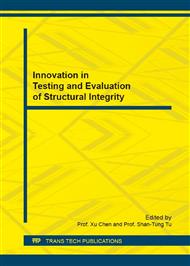[1]
Yang J, Wang G, Xuan F, Tu S, Liu C. Out-of-plane constraint effect on local fracture resistance of a dissimilar metal welded joint. Materials & Design. 55(2014)542-50.
DOI: 10.1016/j.matdes.2013.10.034
Google Scholar
[2]
Budden P, Ainsworth R. The effect of constraint on creep fracture assessments. International Journal of Fracture. 87 (1997)139-49.
Google Scholar
[3]
Biner SB. A numerical analysis of time dependent stress fields ahead of stationary interface cracks at creep regime—Part I. Interface cracks in bimaterials. Engineering Fracture Mechanics. 56(1997)513-29.
DOI: 10.1016/s0013-7944(96)00116-6
Google Scholar
[4]
Hui C-Y, Saif M. Asymptotic stress field of a mode III crack growing along an elastic/elastic power-law creeping bimaterial interface. Journal of Applied Mechanics. 61 (1994) 384-9.
DOI: 10.1115/1.2901455
Google Scholar
[5]
Lee H, Kim Y-J. Interfacial crack-tip constraints and J-integrals in plastically mismatched bi-materials. Engineering Fracture Mechanics. 68(2001)1013-31.
DOI: 10.1016/s0013-7944(01)00007-8
Google Scholar
[6]
Ngampungpis K, Kitamura T, Hirakata H. Effect of Material Thickness on the Singular Stress Field in Elastic-creep Bi-material Interface. Journal of Solid Mechanics and Materials Engineering. 1(2007)744-54.
DOI: 10.1299/jmmp.1.744
Google Scholar
[7]
Yoon K, Kim K. High temperature fracture parameter for a weld interface crack. Theoretical and Applied Fracture Mechanics. 32(1999)27-35.
DOI: 10.1016/s0167-8442(99)00023-3
Google Scholar
[8]
Zerbst U, Ainsworth RA, Beier HT, Pisarski H, Zhang ZL, Nikbin K, et al. Review on fracture and crack propagation in weldments – A fracture mechanics perspective. Engineering Fracture Mechanics. 132(2014)200-76.
DOI: 10.1016/j.engfracmech.2014.05.012
Google Scholar
[9]
Yang J, Wang G, Xuan F, Tu S. Unified correlation of in-plane and out-of-plane constraint with fracture resistance of a dissimilar metal welded joint. Engineering Fracture Mechanics. 115(2014)296-307.
DOI: 10.1016/j.engfracmech.2013.11.018
Google Scholar
[10]
Yamamoto M, Miura N, Ogata T. Effect of constraint on creep crack propagation of mod. 9Cr-1Mo steel weld joint. ASME 2009 Pressure Vessels and Piping Conference: ASME (2009)1533-1539.
DOI: 10.1115/pvp2009-77862
Google Scholar
[11]
Dai Y, Liu D, Liu Y. Mismatch Constraint effect of creep crack with modified boundary layer model. Journal of Applied Mechanics. 83(2016)031008-16.
DOI: 10.1115/1.4032025
Google Scholar
[12]
Dai Y, Liu Y, Chen H. Characterization of mismatch constraint effect for interfacial creep crack with two parameters approach. Engineering Fracture Mechanics. 2016: under review.
Google Scholar
[13]
Zhang Z, Hauge M, Thaulow C. Two-parameter characterization of the near-tip stress fields for a bi-material elastic-plastic interface crack. International Journal of Fracture. 79(1996)65-83.
DOI: 10.1007/bf00017713
Google Scholar


